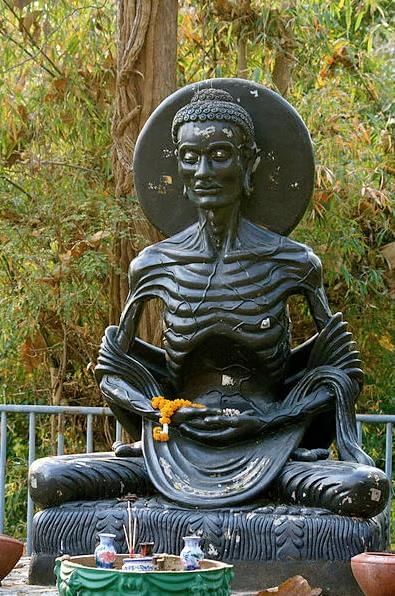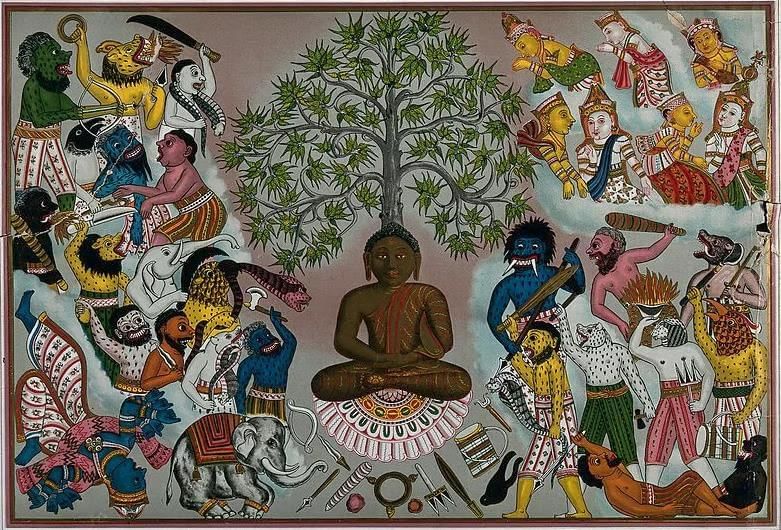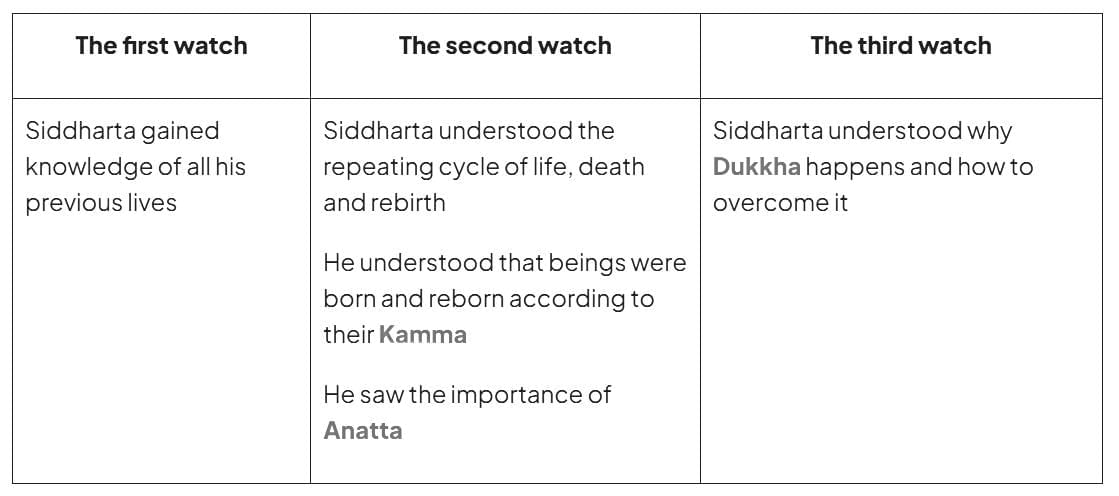Year 11 Exam > Year 11 Notes > Religion, Philosophy & Ethics for GCSE/IGCSE > Buddha's Ascetic Life & Enlightenment
Buddha's Ascetic Life & Enlightenment | Religion, Philosophy & Ethics for GCSE/IGCSE - Year 11 PDF Download
| Table of contents |

|
| The Buddha’s Ascetic Life |

|
| Siddharta became dangerously thin while living an ascetic lifestyle |

|
| Siddharta Turns Away from Ascetism |

|
| The Buddha's Enlightenment |

|
The Buddha’s Ascetic Life
- Ascetics adopt a rigorous and minimalistic lifestyle, owning very few possessions.
- Siddhartha embraced asceticism for six years in his quest to resolve the issue of suffering:
- He was motivated to live as an ascetic after being inspired by a holy man, whom he encountered during the last of the Four Sights.
- His ascetic lifestyle included:
- Residing in perilous forests
- Sleeping on a bed made of thorns
- Consuming so little food that he became extremely thin and frail
- During this period, Siddhartha studied under various spiritual teachers and mastered the practice of meditation.
Siddharta became dangerously thin while living an ascetic lifestyle

Siddharta Turns Away from Ascetism
- Throughout his six years of ascetic practices, Siddhartha developed strong discipline.
- However, he still had not discovered a solution to the problem of suffering:
“When the Great Being engaged in intense austerities for six years, it felt to him as though he were weaving knots across the sky” (The Jataka, vol. 1, p.67).
- One day, Siddhartha accepted a bowl of rice and milk from a cowgirl.
- This restored his energy, prompting him to abandon the ascetic lifestyle.
“Recognizing that such extreme austerities would not lead to Enlightenment, he began collecting alms in villages and towns” (The Jataka, vol. 1, p.67).
- Siddhartha came to understand that neither a life of luxury nor one of extreme self-denial would grant him spiritual wisdom.
- He realized he needed to pursue a middle path between these two extremes.
The Buddha's Enlightenment
Siddharta’s Meditation
- Siddhartha recognized that neither indulgence in luxury nor harsh self-denial was the correct path to spiritual awakening.
- He chose a third approach, the “middle way” of meditation.
- Siddhartha vowed to continue meditating until he achieved enlightenment:
- “I will not rise from this seat of meditation until I attain supreme Enlightenment” (The Buddha in the Jataka, vol. 1, p.71).
- As he meditated, traditional accounts describe how the demon Mara repeatedly appeared to challenge him.
- Mara attempted to divert Siddhartha’s focus through tactics such as:
- Sending his daughters to tempt Siddhartha
- Deploying armies to attack him
- Offering him dominion over his kingdom
- Questioning his legitimacy to occupy the seat of enlightenment
- Siddhartha relied on his self-discipline to resist these distractions.
- He remained steadfast in his meditation.

The Buddha’s Enlightenment
Siddhartha attained enlightenment through three profound realizations, which occurred during different phases of the night, known as the three watches of the night.
The Enlightenment

- Following his enlightenment, Siddhartha became known as the Buddha, meaning “the enlightened one” or “the fully awakened one.”
- He first shared his spiritual insights with the five ascetics, who became his initial disciples.
- He encouraged his followers to adopt a middle way, balancing between the extremes of luxury and asceticism.
- His teachings, known as the Dhamma, guide Buddhists on the path to reducing Dukkha and achieving enlightenment in their own lives.
The document Buddha's Ascetic Life & Enlightenment | Religion, Philosophy & Ethics for GCSE/IGCSE - Year 11 is a part of the Year 11 Course Religion, Philosophy & Ethics for GCSE/IGCSE.
All you need of Year 11 at this link: Year 11
|
172 docs|3 tests
|
FAQs on Buddha's Ascetic Life & Enlightenment - Religion, Philosophy & Ethics for GCSE/IGCSE - Year 11
| 1. What was Siddhartha's ascetic lifestyle like before his enlightenment? |  |
Ans. Siddhartha engaged in extreme ascetic practices, believing that self-denial and extreme fasting would lead him to spiritual awakening. He adopted a lifestyle that included minimal food intake, leading to dangerous weight loss and physical weakness. His asceticism was marked by harsh meditation, deprivation, and rigorous discipline.
| 2. Why did Siddhartha turn away from asceticism? |  |
Ans. Siddhartha realized that extreme asceticism did not bring him closer to enlightenment; instead, it left him weak and unable to meditate effectively. He understood that neither indulgence nor extreme deprivation led to true understanding. This revelation prompted him to seek a middle path, balancing discipline with moderation.
| 3. What event marked the beginning of Siddhartha's journey towards enlightenment? |  |
Ans. The pivotal moment in Siddhartha's journey was when he sat under the Bodhi tree, vowing not to rise until he attained enlightenment. This decision signified his commitment to meditation and introspection, leading to profound realizations about suffering, desire, and the nature of existence.
| 4. How did Siddhartha achieve enlightenment? |  |
Ans. Siddhartha achieved enlightenment through deep meditation and insight. During his meditation under the Bodhi tree, he confronted his past, understood the nature of suffering, and realized the Four Noble Truths. This transformative experience led to his awakening as the Buddha, or "the Enlightened One."
| 5. What are the Four Noble Truths that emerged from Buddha's enlightenment? |  |
Ans. The Four Noble Truths are fundamental teachings of Buddhism:
1. The truth of suffering (Dukkha) – life involves suffering and dissatisfaction.
2. The cause of suffering (Samudaya) – suffering is caused by desire and attachment.
3. The cessation of suffering (Nirodha) – it is possible to end suffering.
4. The path to the cessation of suffering (Magga) – following the Eightfold Path leads to the end of suffering and enlightenment.
Related Searches














